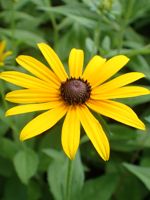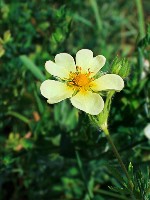Mon-Fri 9am - 5pm Mountain time
Pennsylvania Cinquefoil vs Black-Eyed Susan
Rudbeckia hirta
Potentilla pensylvanica
NOT AVAILABLE THIS SEASON - MIGHT RETURN
NOT AVAILABLE THIS SEASON - MIGHT RETURN
Black-Eyed Susan is a striking native wildflower known for its bright yellow, daisy-like flowers with dark center disks. With deadheading, the plant can bloom for an extended period, from mid-summer to early fall. These cheerful flowers attract a variety of pollinators, including bees and butterflies. Adding to its ecological value, the plant also acts as a host for the Wavy-Lined Emerald Moth (Synchlora aerata) and the Silvery Checkerspot (Chlosyne nycteis) butterfly.
While it is typically a short-lived perennial or biennial, the plant freely self-seeds. This allows it to persist in the landscape, particularly in natural areas where it can spread and establish itself. This plant is drought-tolerant, salt-tolerant, and deer and rabbit-resistant, making it ideal for challenging environments. The Black-Eyed Susan is well suited to wildflower gardens, pollinator gardens, as well as slopes, banks, and naturalized areas.
Pennsylvania Cinquefoil is well suited for naturalisation projects as it is a wildflower native to North America. It is widespread and can be found growing in rocky soils at higher elevations in the mountains and foothills, as well as the dry prairies. The Pennsylvania Cinquefoil is capable of growing in cold, harsh conditions. The bright yellow flowers are found at the top of long stalks in small dense clusters and are ideal for attracting pollinators.

